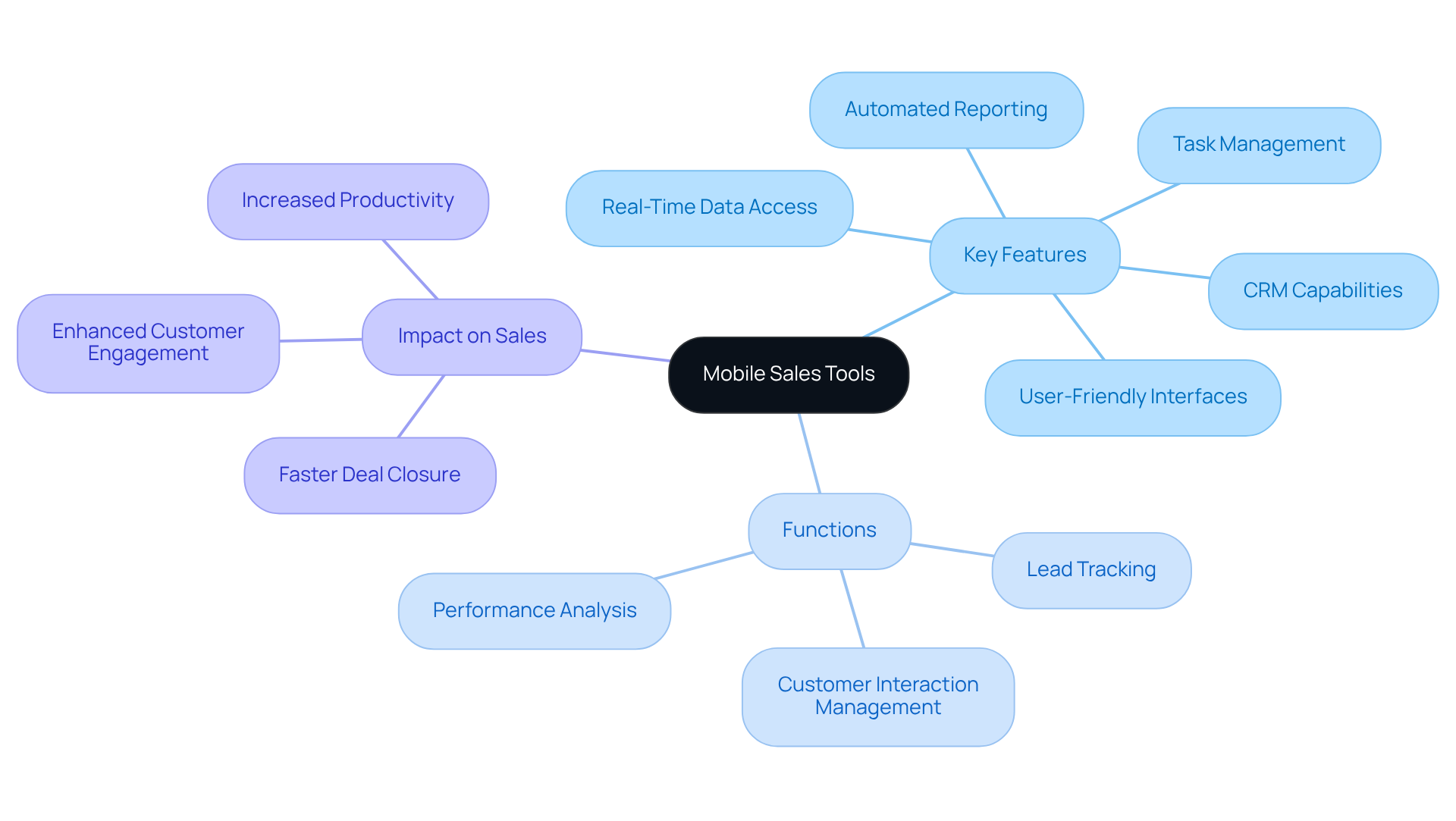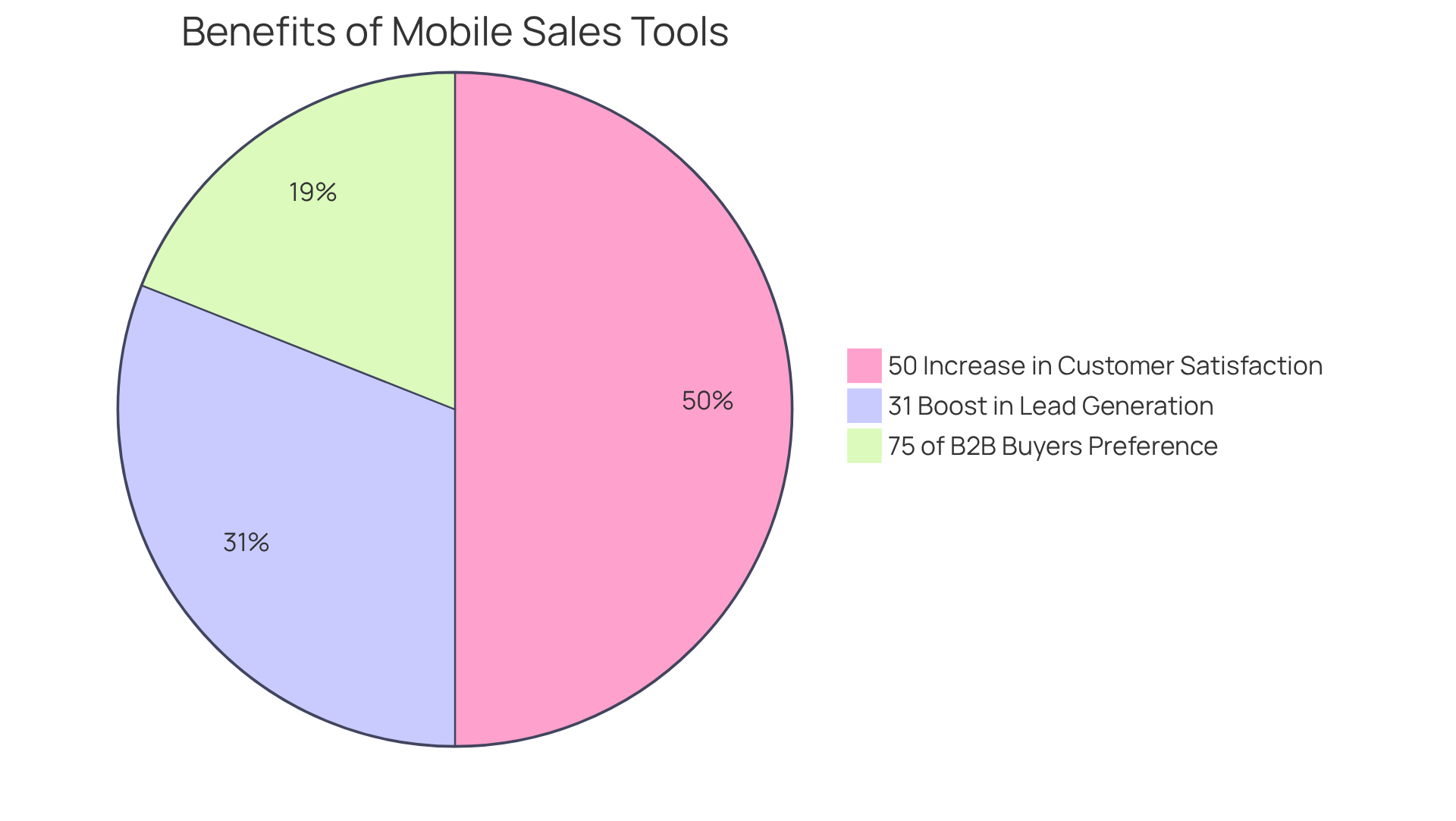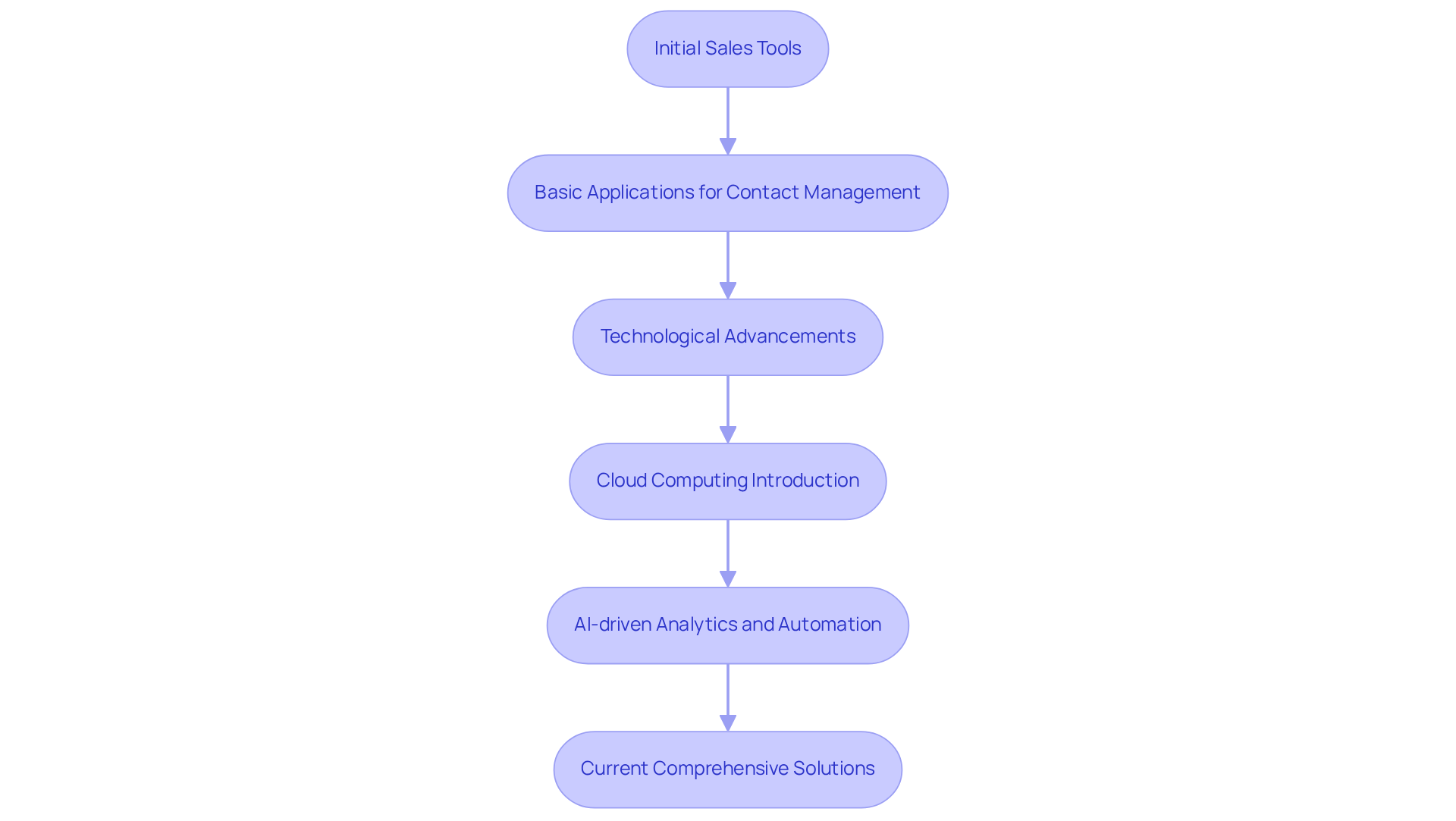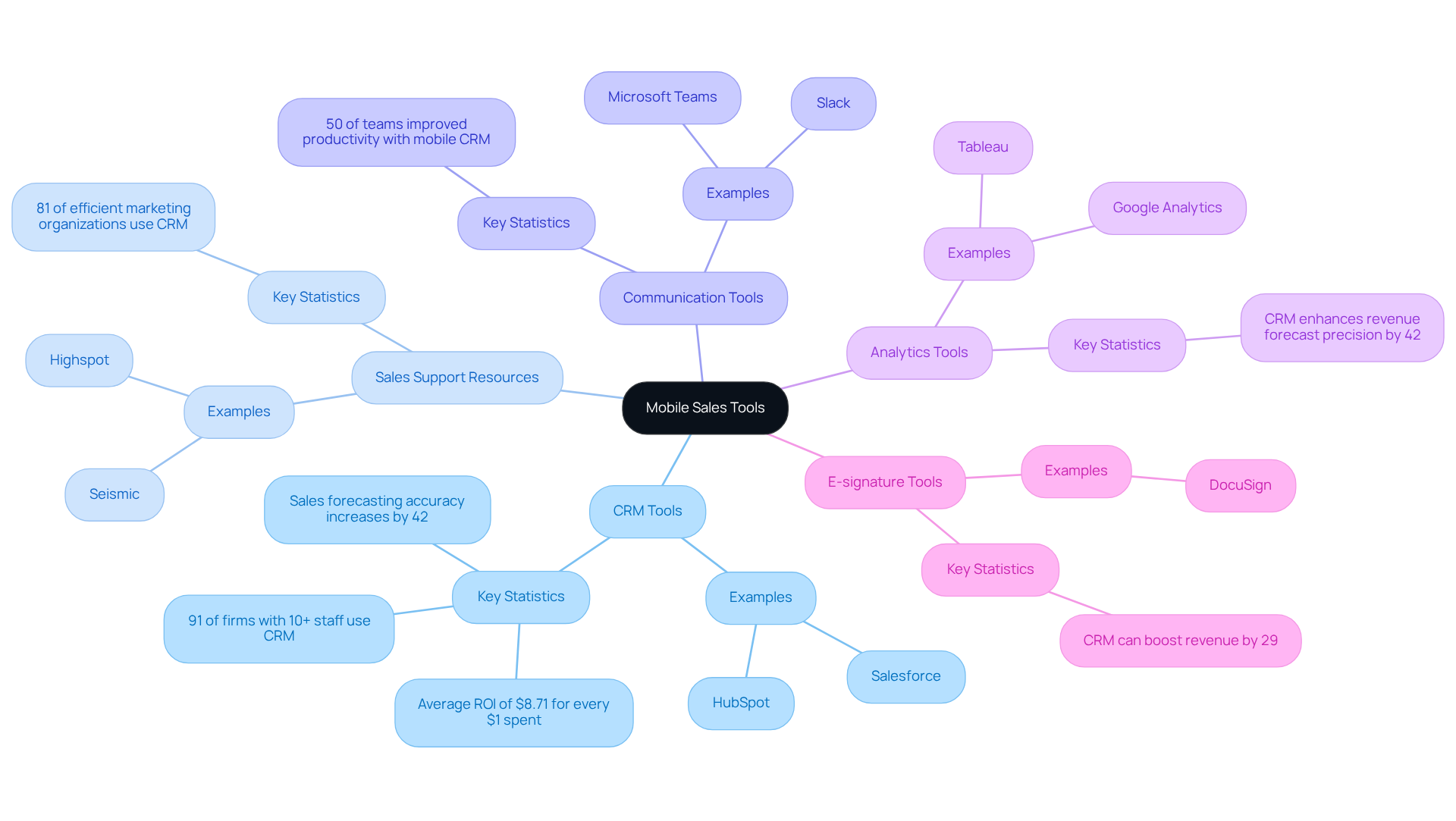
Understanding Mobile Sales Tool: Features, Importance, and Evolution
Natural Language Processing in BusinessOverview
This article delves into the critical role of mobile sales tools by thoroughly examining their features, significance, and evolution within contemporary sales strategies. It underscores that these tools are indispensable for boosting productivity and enhancing customer satisfaction. By providing sales professionals with real-time access to essential information and analytics, mobile sales tools ultimately lead to heightened efficiency and substantial revenue growth.
Introduction
The landscape of sales is undergoing a significant transformation, with mobile sales tools emerging as essential resources for professionals aiming to thrive in an increasingly competitive environment. These applications not only boost productivity but also facilitate seamless customer engagement, rendering them indispensable as businesses gear up for the future.
However, as reliance on these tools intensifies, critical questions emerge regarding their actual impact on sales performance and the evolving features that will shape their effectiveness in the years ahead.
How can sales teams harness these technologies to not only meet but surpass customer expectations?
Define Mobile Sales Tool: Key Features and Functions
Mobile sales applications are essential software programmes that empower sales professionals to manage their tasks effectively while on the move. As we approach 2025, these tools have significantly evolved, incorporating innovative features such as enhanced customer relationship management (CRM) capabilities, real-time data access, and sophisticated sales analytics. With 73% of sales experts utilising mobile sales resources, their role in boosting productivity is undeniable.
Key elements of modern mobile sales solutions include:
- Automated reporting
- Task management
- Seamless integration with other business applications
These functionalities enable sales teams to track leads, manage customer interactions, and analyse performance metrics directly from their handheld devices. A case study on a leading sales application revealed that teams leveraging these tools close deals three times faster, thanks to improved access to critical information and streamlined processes.
Experts emphasise the significance of the mobile sales tool in today’s fast-paced environment. Sales professionals increasingly rely on these resources to enhance their efficiency and responsiveness. Features such as:
- Intuitive search capabilities
- Offline access to vital documents
- User-friendly interfaces
are essential for sustaining productivity, particularly when representatives are in the field.
Real-world examples underscore the features of mobile sales tools, showcasing how they facilitate personalised customer engagement and timely follow-ups through CRM. As organisations continue to prioritise mobile solutions, the integration of advanced analytics and communication tools will further elevate the effectiveness of sales personnel, ensuring they remain competitive in an ever-evolving marketplace.

Explore the Importance of Mobile Sales Tools in Modern Sales Strategies
Mobile sales tools have become indispensable in contemporary sales strategies, driven by the urgent demand for adaptability and swift responses in customer interactions. These resources act as a mobile sales tool that empowers sales teams to access vital information and engage with clients in real time, fostering quicker decision-making and significantly enhancing customer satisfaction. Businesses leveraging a mobile sales tool report a remarkable 50% increase in customer satisfaction levels, as this tool facilitates seamless communication and collaboration.
Moreover, the ability to analyse revenue data on the go allows teams to refine their strategies and concentrate on high-impact activities. Notably, 81% of revenue leaders assert that the use of a mobile sales tool in their operations leads to improved efficiency and engagement. Practical examples underscore this impact: organisations utilising mobile commerce applications have witnessed a 31% boost in lead generation and a substantial increase in conversion rates.
As we approach 2025, the importance of the mobile sales tool will only intensify, with 75% of B2B buyers preferring to engage with suppliers through digital platforms. This shift underscores the necessity for sales teams to adopt mobile solutions that not only enhance operational efficiency but also foster stronger relationships with clients, ultimately driving revenue growth.

Trace the Evolution of Mobile Sales Tools: From Concept to Essential Resource
The evolution of portable sales instruments is intrinsically linked to the advent of portable computing and the proliferation of smartphones. Initially, sales professionals relied on basic applications for contact management and scheduling. However, with technological advancements, the capabilities of these instruments have significantly expanded. The advent of cloud computing has facilitated real-time data synchronisation, while advancements in application development have introduced sophisticated features such as AI-driven analytics and automation. Today, mobile sales tools are indispensable assets that seamlessly integrate with other business systems, providing sales teams with comprehensive solutions tailored to meet their diverse needs.

Identify Different Types of Mobile Sales Tools: A Comprehensive Overview
Mobile sales tools can be classified into several types, with each type serving distinct purposes within the sales process.
-
Customer Relationship Management (CRM) Tools: These applications are vital for sales groups to handle customer interactions, monitor leads, and evaluate revenue data. Notable examples include Salesforce and HubSpot, which are widely recognised for their robust features. Indeed, 91% of firms with 10 or more staff members employ CRM software, emphasising its essential function in operational processes. Furthermore, the average return on investment for CRM is $8.71 for each dollar invested, highlighting the financial advantages of these resources.
-
Sales Support Resources: Created to provide sales groups with the essential materials and insights, these resources improve customer interaction. Platforms such as Seismic and Highspot offer valuable content and insights that enable representatives to connect effectively with prospects. The most efficient marketing organisations are 81% more likely to engage in consistent CRM utilisation than unproductive groups, underscoring the significance of these resources in fostering successful sales strategies.
-
Communication Tools: Applications like Slack and Microsoft Teams enable real-time interaction and cooperation among sales groups. These tools are vital for maintaining seamless interactions, especially in remote work environments, where 50% of teams improved their productivity by using a mobile CRM.
-
Analytics Tools: Instruments such as Tableau and Google Analytics allow professionals to examine performance metrics and customer behaviour, guiding strategic decisions. With CRM applications enhancing revenue forecast precision by up to 42%, utilising analytics is essential for refining marketing strategies.
-
E-signature Tools: Solutions like DocuSign simplify the contract signing procedure, enabling teams to finalise agreements more quickly. The effectiveness achieved from these resources can greatly diminish the time allocated to administrative duties, allowing representatives to concentrate on boosting conversions. Furthermore, CRM applications can assist in boosting revenue by as much as 29%, connecting the efficiency of e-signature solutions to overall revenue performance.
By understanding the different types of mobile sales tools available, organisations can better align their investments in technology with their sales objectives. Ultimately, this alignment enhances overall performance in a competitive market.

Conclusion
Mobile sales tools have fundamentally transformed the operations of sales professionals, evolving into essential assets that significantly enhance productivity and customer engagement. As these tools continue to advance, their innovative features and functionalities empower sales teams to access crucial information, streamline processes, and cultivate stronger relationships with clients. The increasing reliance on mobile solutions underscores their vital role in adapting to the fast-paced demands of the modern market.
Key insights throughout this article highlight the multifaceted nature of mobile sales tools, showcasing their capabilities in customer relationship management, real-time data access, and advanced analytics. The surge in user adoption, along with compelling statistics that demonstrate improved customer satisfaction and lead generation, reinforces the profound impact these tools have on sales performance. Furthermore, classifying various types of mobile sales tools illustrates how organisations can strategically align their technology investments to meet specific sales objectives.
In a landscape where 75% of B2B buyers prefer digital engagement, the integration of mobile sales tools is not merely a trend; it is a necessity for success. Embracing these tools can dramatically enhance operational efficiency, drive revenue growth, and ensure sales teams remain competitive. The future of mobile sales tools is indeed bright, and organisations that prioritise their implementation are poised to reap substantial benefits in performance and customer satisfaction as they navigate the evolving sales environment.
Frequently Asked Questions
What is a mobile sales tool?
A mobile sales tool is a software application designed to help sales professionals manage their tasks effectively while on the move, incorporating features like customer relationship management (CRM), real-time data access, and sales analytics.
What are the key features of modern mobile sales solutions?
Key features include automated reporting, task management, seamless integration with other business applications, intuitive search capabilities, offline access to vital documents, and user-friendly interfaces.
How do mobile sales tools impact productivity?
Mobile sales tools significantly boost productivity, with a case study showing that teams using these tools close deals three times faster due to improved access to critical information and streamlined processes.
Why are mobile sales tools important for sales professionals?
They are essential for enhancing efficiency and responsiveness in today’s fast-paced environment, allowing sales representatives to track leads, manage customer interactions, and analyse performance metrics while in the field.
What future developments are expected in mobile sales tools?
Future developments are likely to include the integration of advanced analytics and communication tools, which will further enhance the effectiveness of sales personnel and help them remain competitive in the marketplace.
Enjoyed this post? Share it with your network!
10 Best AI Sales Tools to Boost Your Team’s Performance

Discover the top 10 best AI sales tools to enhance team performance and drive revenue growth.
Mastering Test Call Numbers: A Step-by-Step Guide for Sales Directors

Elevate your communication with our guide on mastering test call numbers for sales success.
7 Ways Automated Outbound Calls Boost Sales Performance

Discover how automated outbound calls enhance sales performance and streamline communication.
